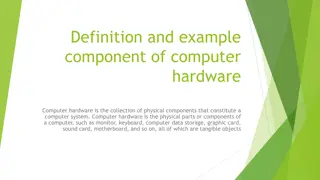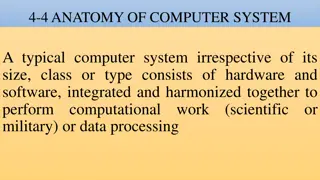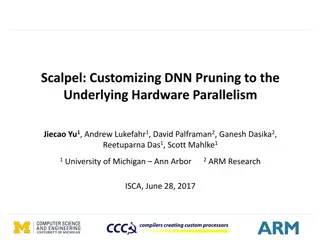Hardware-Based Secure Services: Past and Future
Evolution of hardware-based secure services and the challenges in accessing Secure Element APIs. Insights on web platform integration, Web Authentication API, and the future of secure token technology. Recommendations for standard services and security models on the open web platform.
Download Presentation

Please find below an Image/Link to download the presentation.
The content on the website is provided AS IS for your information and personal use only. It may not be sold, licensed, or shared on other websites without obtaining consent from the author.If you encounter any issues during the download, it is possible that the publisher has removed the file from their server.
You are allowed to download the files provided on this website for personal or commercial use, subject to the condition that they are used lawfully. All files are the property of their respective owners.
The content on the website is provided AS IS for your information and personal use only. It may not be sold, licensed, or shared on other websites without obtaining consent from the author.
E N D
Presentation Transcript
Hardware-based secure services past and future Olivier POTONNIEE, Aur lien COUVERT, Virginie GALINDO April 2016
What we did around Secure Element . Sys APP WG proposal Opening a communication channel with Secure Element Does not fit Web Crypto API for hardware token Too early Web Crypto . Next workshop in Sept 2014 Promoting secure element and FIDO authentication Web Authentication WG Up and running W3C status Sept 2014 2
Why is not there yet an API to access Secure Element ? Education matters Web dev don t want to speak APDU Browser makers neither Power industry matters We are only few security vendors in W3C More device and security players are joining : Banks, Visa, Tyfone, Chipset makers, SE value are not straightforward for browser makers They live in a on-line, real time, risk management world They know how to deal with secure browser, secure enough storage Concern with privacy and security Services in SE made accessible to everyone is a privacy concern No security solution for access control has been convincing enough up to now W3C perspectives on SE internal use only 3
What we see for the open web platform. There are some standard services that web app could benefit Cryptography operation and storage Citizen identity Payment services Abstraction : what ever is the hardware-based token flavor The W3C should not worry about integration aspects TEE and secure element are used in transparent way in platforms See iOSSecure Enclave, android hardware-key, android Trusty framework, android fingerprint API, and some mobile payment solutions W3C status Sept 2014 4
Example of Web Authentication API. The level of service is Enroll authenticator Authenticate W3C defines attestation, signature and service parameters The implementers manage the FIDO Client and enumeration/communication with the authenticators Security model is HTTPS SOP Centralized server checking device attestation, behing the web app domain W3C status Sept 2014 5
Our suggestion for having some hardware-based secure services happening Pick one or two use cases Design the basic services we need Prototype integration with UA vendor And improve W3C status Sept 2014 6
Sharing with you some technical thoughts . Footer, 20xx-xx-xx 7
Low level Secure Element APIs PC/SC Open Mobile API (OMAPI) 8.1: 10: Secure Elements in Web Applications 8
Cross-Platform Secure Element (SE) API Web Applications Runtime Web Secure Element API Access Control PC/SC OMAPI (Android) NFC OS (MSWindows, MacOS, Linux) Desktop Mobile Secure Elements in Web Applications 9
Secure Element API Standardization Proposed to W3C (SysApps & WebCrypto WGs) http://opoto.github.io/secure-element/ Transferred to a GlobalPlatform WG https://github.com/globalplatform Under public review here http://globalplatform.github.io/WebApis-for-SE/doc/. Implementation Included in Firefox OS 2.2 (June 2015) Secure Elements in Web Applications 10
Web API for accessing Secure Element Secure Elements in Web Applications 11
Secure Element API Transport-level API (similar to SIM Alliance s OMAPI) Enumerate readers SE insertion / removal events Secure Element Manager Is SE present? Connect to SE Reader SE ATR Connect to Applet Session Basic / Logical Transmit APDUs Channel Secure Elements in Web Applications 12
Access Control Toolbox Secure Element Security Model Web Security Model Permissions: Access to device/resources (GPS, storage, etc ) PIN Secure Messaging Mutual AuthentN Same Origin Policy (SOP): Data isolation per domain GlobalPlatform Access Control Secure Elements in Web Applications 13
Access Control (1/2): The Web Secure Element Security Model Web Security Model Permissions: Access to device/resources (GPS, storage, etc ) PIN Secure Messaging Mutual AuthentN Same Origin Policy (SOP): Data isolation per domain GlobalPlatform Access Control Secure Elements in Web Applications 14
Domain-binded SE apps (SOP compliant) An SE app with one credential per domain An SE app is tied to a single domain, which hosts a centralized service Other apps use a delegation protocol to use the centralized service Service Provider (Relying Party) SAML/OpenID Connect Identity Provider Login Authenticate Secure Elements in Web Applications 15
Access Control (2/2): Secure Elements Secure Element Security Model Web Security Model Permissions: Access to device/resources (GPS, storage, etc ) PIN Secure Messaging Mutual AuthentN Same Origin Policy (SOP): Data isolation per domain GlobalPlatform Access Control Secure Elements in Web Applications 16
GlobalPlatform Access Control Access Rule: Authorizes a specific app on device to access a specific app on SE [and send specific commands] User Device Application Access Control Enforcer SE Application Cached Access Rules Access Rules http://www.globalplatform.org/specificationsdevice.asp Secure Elements in Web Applications 17
Secure Element API to build Trusted Services Web Applications Public APIs Web Runtime Privilege apps, e.g. Extensions Reload AuthentN Signature Payment Restricted APIs Secure Element API Access Control Secure Elements in Web Applications 18
The security palette Secure Element Built-ins GlobalPlatform Access Control Trusted Services Domain Binding Secure Elements in Web Applications 19
Or something completely different ! a REST API provided by those privileged apps No need to comply with SOP but authentication could be managed by well deplowed techno like OAUTH Permission, privileged context, SRI, CSP, CORS Footer, 20xx-xx-xx 20























